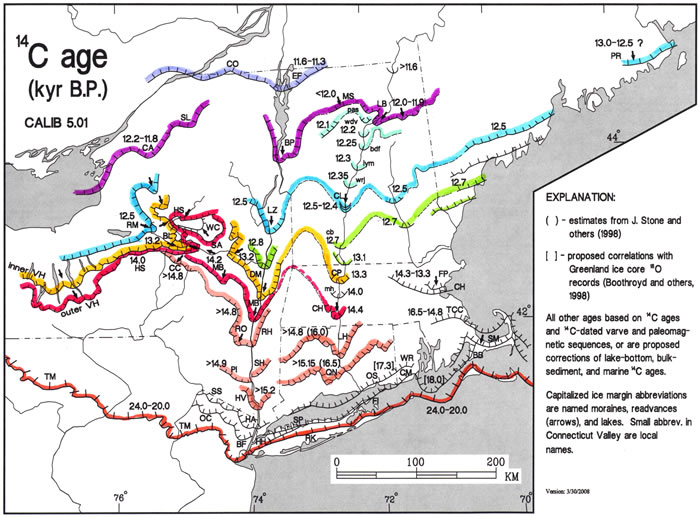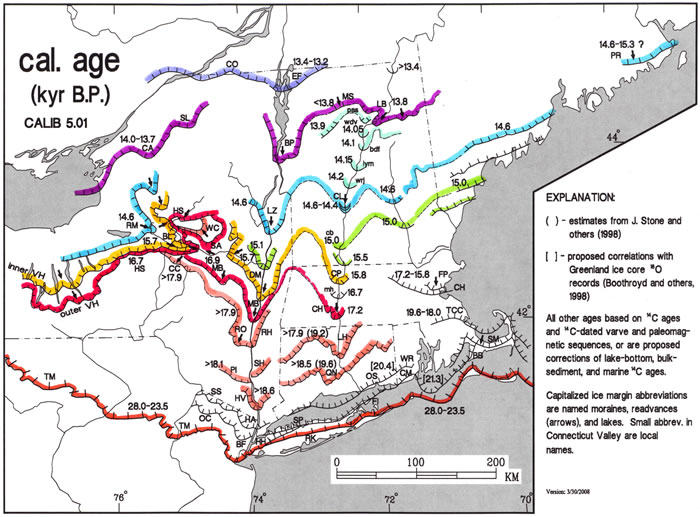The NEVC and Deglaciation of the Northeastern U.S.
In the northeastern U.S., varve records that include basal and ice-proximal varves have been matched to the NEVC. This allows the formulation of the history and rates of deglaciation. Such a reconstruction of deglaciation was first performed by Antevs (1922) who also tabulated rates of deglaciation for the Connecticut and Merrimack valleys. The map below was compiled by J.W. Goldthwait (in Antevs, 1922) and in addition to showing positions of ice recession in varve years, as formulated by Antevs, has a compilation of all end moraines, ice flow directions, and erratic trains known at the time. For a more detailed discussion of the history of Antevs� work on varves and deglaciation click here.
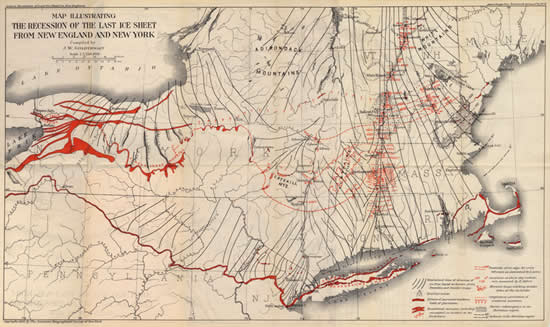
Compiled by J.W. Goldthwait, Plate VI of Antevs (1922). Click image for high resolution version (~530 KB JPEG).
Connecticut Valley Deglaciation
Since Antevs� time a refinement of the history of deglaciation has occurred in the Connecticut Valley from southern Massachusetts to northern New Hampshire and Vermont as new basal and ice-proximal varve localities have been found and glacial readvances have been documented in several places. The general trend we see today is for an overall acceleration of ice recession for three separate periods of deglaciation each following a period of readvance.
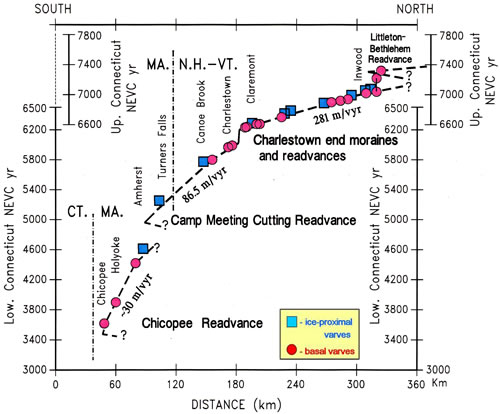
Deglaciation of the Connecticut Valley. The Claremont gap has been corrected on this diagram. NE 6300 below the gap now corresponds to NE 6632 above the gap. See text for further description. Click on image for a high resolution version (~900 KB JPEG).
Merrimack Valley Deglaciation
A similar analysis exists in the Merrimack Valley of southern New Hampshire although it does not represent nearly as long a period of deglaciation. No new ice-proximal or basal varve sites have been found since the time of Antevs as shown on the profile with the time spans of all known varve records. Antevs varve records are in blue while new sites are in red. The rate of deglaciation in the Merrimack Valley (~100 m/vyr) matches very closely the corresponding time of deglaciation in the Connecticut Valley (southern New Hamshire and Vermont).
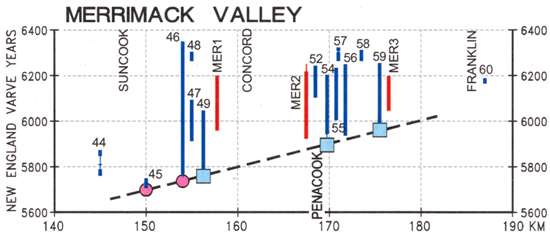
Deglaciation of the Merrimack Valley. See text for description. Click on image for high resolution version (~450 KB JPEG).
Deglaciation in the Northeastern U.S.
With the addition of paleomagnetic correlations (See NEVC Paleomagnetism page) between western New England, the western Mohawk Valley of central New York, and the Champlain Valley, as well as the current calibration of the NEVC (See NEVC Calibration page), it has been possible to reconstruct a more comprehensive deglaciation history for the northeastern U.S (see Ridge, 2003, 2004 for initial reconstructions that are updated here). Deglaciation on the maps below has been plotted in terms of radiocarbon and calibrated years based on the radiocarbon calibration of the NEVC. In western New England deglaciation is directly tied to the varve chronology from southern Massachusetts northward. Ice recession lines in eastern Massachusetts, Connecticut, and Rhode Island have limiting ages placed on them from varve analysis and age estimates based on inferred correlations of end moraines and ages of features in ice core records (Boothroyd et al., 1998; Stone et al., 1998).
References
- Boothroyd, J., Freedman, J.H., Brenner, H.B., Stone, J.R., 1998, The glacial geology of southern Rhode Island. In: Murray, D.P. (ed.), Guidebook to Field Trips in Rhode Island and Adjacent Regions of Connecticut and Massachusetts. 90th New England Intercollegiate Geological Conference, Kingston, Rhode Island, p. C5: 1-25.
- Ridge, J.C., 2003, Chapter 3: The last deglaciation of the northeastern United States: a combined varve, paleomagnetic, and calibrated 14C chronology, in Cremeens, D.L. and Hart, J.P., eds., Geoarchaeology of Landscapes in the Glaciated Northeast: New York State Museum Bulletin 497, p. 15-45.
- Ridge, J.C., 2004, The Quaternary glaciation of western New England with correlations to surrounding areas, in Ehlers, J. & Gibbard, P.L. (eds.), Quaternary Glaciations � Extent and Chronology, Part II: North America. Developments in Quaternary Science, vol. 2B, Amsterdam, Elsevier, p. 163-193.
- Stone, J.R., Schafer, J.P., London, E.H., Lewis, R.L., DiGiacomo-Cohen, M.L., Thompson, W.B., 1998, Quaternary geologic map of Connecticut and Long Island Sound Basin (scale 1:175,000). United States Geological Survey, Open-file Report 98-371, 1 sheet, 77 p.

